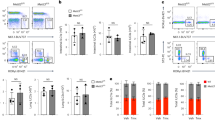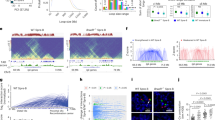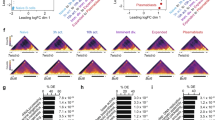Abstract
Cell identity is determined by selective gene activation and by the maintenance of other regulated genes in a silent state. Although activation mechanisms have been dissected in considerable depth, great strides towards an understanding of the molecular control of gene silencing have been made only recently. Molecular hallmarks of silent chromatin and proteins involved in its assembly and maintenance have been identified through genetic, cytological and biochemical studies in a variety of organisms. Immunologists are now beginning to use this knowledge to elucidate mechanisms underlying cell fate decisions and key developmental steps. This review surveys the current knowledge of gene silencing, with an emphasis on studies in lymphocytes that are advancing our general understanding of silencing mechanisms during development.
This is a preview of subscription content, access via your institution
Access options
Subscribe to this journal
Receive 12 print issues and online access
$209.00 per year
only $17.42 per issue
Buy this article
- Purchase on Springer Link
- Instant access to full article PDF
Prices may be subject to local taxes which are calculated during checkout



Similar content being viewed by others
References
Fisher, A.G. Cellular identity and lineage choice. Nat. Rev. Immunol. 2, 977–982 (2002).
Fisher, A.G. & Merkenschlager, M. Gene silencing, cell fate and nuclear organisation. Curr. Opin. Genet. Dev. 12, 193–197 (2002).
Grewal, S.I. & Elgin, S.C. Heterochromatin: new possibilities for the inheritance of structure. Curr. Opin. Genet. Dev. 12, 178–187 (2002).
Ellmeier, W., Sawada, S. & Littman, D.R. The regulation of CD4 and CD8 coreceptor gene expression during T cell development. Annu. Rev. Immunol. 17, 523–554 (1999).
Kioussis, D. & Ellmeier, W. Chromatin and CD4, CD8A and CD8B gene expression during thymic differentiation. Nat. Rev. Immunol. 2, 909–919 (2002).
Murphy, K.M. & Reiner, S.L. The lineage decisions of helper T cells. Nat. Rev. Immunol. 2, 933–944 (2002).
Szabo, S.J., Sullivan, B.M., Peng, S.L. & Glimcher, L.H. Molecular mechanisms regulating Th1 immune responses. Annu. Rev. Immunol. 21, 713–758 (2003).
Smale, S.T. & Fisher, A.G. Chromatin structure and gene regulation in the immune system. Annu. Rev. Immunol. 20, 427–462 (2002).
Richards, E.J. & Elgin, S.C. Epigenetic codes for heterochromatin formation and silencing: rounding up the usual suspects. Cell 108, 489–500 (2002).
Vermaak, D., Ahmad, K. & Henikoff, S. Maintenance of chromatin states: an open-and-shut case. Curr. Opin. Cell Bio. 15, 266–274 (2003).
Bird, A. DNA methylation patterns and epigenetic memory. Genes Dev. 16, 6–21 (2002).
Rea, S. et al. Regulation of chromatin structure by site-specific histone H3 methyltransferases. Nature 406, 593–599 (2000).
Kouzarides, T. Histone methylation in transcriptional control. Curr. Opin. Genet. Dev. 12, 198–209 (2002).
Lachner, M. & Jenuwein, T. The many faces of histone lysine methylation. Curr. Opin. Cell Biol. 14, 286–298 (2002).
Litt, M.D., Simpson, M., Gaszner, M., Allis, C.D. & Felsenfeld, G. Correlation between histone lysine methylation and developmental changes at the chicken β-globin locus. Science 293, 2453–2455 (2001).
Peters, A.H. et al. Histone H3 lysine 9 methylation is an epigenetic imprint of facultative heterochromatin. Nat. Genet. 30, 77–80 (2002).
Saccani, S. & Natoli, G. Dynamic changes in histone H3 Lys 9 methylation occurring at tightly regulated inducible inflammatory genes. Genes Dev. 16, 2219–2224 (2002).
Bannister, A.J. et al. Selective recognition of methylated lysine 9 on histone H3 by the HP1 chromo domain. Nature 410, 120–124 (2001).
Lachner, M., O'Carroll, D., Rea, S., Mechtler, K. & Jenuwein, T. Methylation of histone H3 lysine 9 creates a binding site for HP1 proteins. Nature 410, 116–120 (2001).
Sun, F.L., Cuaycong, M.H. & Elgin, S.C. Long-range nucleosome ordering is associated with gene silencing in Drosophila melanogaster pericentric heterochromatin. Mol. Cell. Biol. 21, 2867–2879 (2001).
Gasser, S.M. Positions of potential: nuclear organization and gene expression. Cell 104, 639–642 (2001).
Hediger, F. & Gasser, S.M. Nuclear organization and silencing: putting things in their place. Nat. Cell Biol. 4, E53–55 (2002).
Choo, K.H. Domain organization at the centromere and neocentromere. Dev. Cell 1, 165–177 (2001).
Dillon, N. & Festenstein, R. Unravelling heterochromatin: competition between positive and negative factors regulates accessibility. Trends Genet. 18, 252–258 (2002).
Heitz, E. Das Heterochromatin der Moose. Jahrb. Wiss. Botanik 69, 762–818 (1928).
Dhillon, N. & Kamakaka, R.T. Breaking through to the other side: silencers and barriers. Curr. Opin. Genet. Dev. 12, 188–192 (2002).
Rusche, L.N., Kirchmaier, A.L. & Rine, J. The establishment, inheritance, and function of silenced chromatin in Saccharomyces cerevisiae. Annu. Rev. Biochem. 72, 481–516 (2003).
Sobel, R.E., Cook, R.G., Perry, C.A., Annunziato, A.T. & Allis, C.D. Conservation of deposition-related acetylation sites in newly synthesized histones H3 and H4. Proc. Natl. Acad. Sci. USA 92, 1237–1241 (1995).
Annunziato, A.T. & Hansen, J.C. Role of histone acetylation in the assembly and modulation of chromatin structures. Gene Expr. 9, 37–61 (2000).
Grewal, S.I., Bonaduce, M.J. & Klar, A.J. Histone deacetylase homologs regulate epigenetic inheritance of transcriptional silencing and chromosome segregation in fission yeast. Genetics 150, 563–576 (1998).
Nakayama, J., Rice, J.C., Strahl, B.D., Allis, C.D. & Grewal, S.I. Role of histone H3 lysine 9 methylation in epigenetic control of heterochromatin assembly. Science 292, 110–113 (2001).
Nakayama, J., Klar, A.J. & Grewal, S.I. A chromodomain protein, Swi6, performs imprinting functions in fission yeast during mitosis and meiosis. Cell 101, 307–317 (2000).
Noma, K., Allis, C.D. & Grewal, S.I. Transitions in distinct histone H3 methylation patterns at the heterochromatin domain boundaries. Science 293, 1150–1155 (2001).
Hall, I.M. et al. Establishment and maintenance of a heterochromatin domain. Science 297, 2232–2237 (2002).
Volpe, T.A. et al. Regulation of heterochromatic silencing and histone H3 lysine-9 methylation by RNAi. Science 297, 1833–1837 (2002).
Jenuwein, T. An RNA-guided pathway for the epigenome. Science 297, 2215–2218 (2002).
Wallrath, L. Unfolding the mysteries of heterochromatin. Curr. Opin. Genet. Devel. 8, 147–153 (1998).
Festenstein, R. et al. Locus control region function and heterochromatin-induced position effect variegation. Science 271, 1123–1125 (1996).
Gilbert, D.M. Replication timing and transcriptional control: beyond cause and effect. Curr. Opin. Cell Biol. 14, 377–383 (2002).
Siu, G., Wurster, A.L., Duncan, D.D., Soliman, T.M. & Hedrick, S.M. A transcriptional silencer controls the developmental expression of the CD4 gene. EMBO J. 13, 3570–3579 (1994).
Sawada, S., Scarborough, J.D., Killeen, N. & Littman, D.R. A lineage-specific transcriptional silencer regulates CD4 gene expression during T lymphocyte development. Cell 77, 917–929 (1994).
Zou, Y.R. et al. Epigenetic silencing of CD4 in T cells committed to the cytotoxic lineage. Nat. Genet. 29, 332–336 (2001).
Leung, R.K. et al. Deletion of the CD4 silencer element supports a stochastic mechanism of thymocyte lineage commitment. Nat. Immunol. 2, 1167–1173 (2001).
Duncan, D.D., Adlam, M. & Siu, G. Asymmetric redundancy in CD4 silencer function. Immunity 4, 301–311 (1996).
Kim, H.K. & Siu, G. The notch pathway intermediate HES-1 silences CD4 gene expression. Mol. Cell. Biol. 18, 7166–7175 (1998).
Kim, W.W. & Siu, G. Subclass-specific nuclear localization of a novel CD4 silencer binding factor. J. Exp. Med. 190, 281–291 (1999).
Allen, R.D. III, Kim, H.K., Sarafova, S.D. & Siu, G. Negative regulation of CD4 gene expression by a HES-1-c-Myb complex. Mol. Cell. Biol. 21, 3071–3082 (2001).
Taniuchi, I., Sunshine, M.J., Festenstein, R. & Littman, D.R. Evidence for distinct CD4 silencer functions at different stages of thymocyte differentiation. Mol. Cell 10, 1083–1096 (2002).
Taniuchi, I. et al. Differential requirements for Runx proteins in CD4 repression and epigenetic silencing during T lymphocyte development. Cell 111, 621–633 (2002).
Bae, S.C. & Ito, Y. Regulation mechanisms for the heterodimeric transcription factor, PEBP2/CBF. Histol. Histopathol. 14, 1213–1221 (1999).
Wheeler, J.C., Shigesada, K., Gergen, J.P. & Ito, Y. Mechanisms of transcriptional regulation by Runt domain proteins. Semin. Cell Dev. Biol. 11, 369–375 (2000).
Levanon, D. et al. Transcriptional repression by AML1 and LEF-1 is mediated by the TLE/Groucho corepressors. Proc. Natl. Acad. Sci. USA 95, 11590–11595 (1998).
Lutterbach, B. et al. A mechanism of repression by acute myeloid leukemia-1, the target of multiple chromosomal translocations in acute leukemia. J. Biol. Chem. 275, 651–656 (2000).
Chi, T.H. et al. Reciprocal regulation of CD4/CD8 expression by SWI/SNF-like BAF complexes. Nature 418, 195–199 (2002).
Kingston, R.E. & Narlikar, G.J. ATP-dependent remodeling and acetylation as regulators of chromatin fluidity. Genes Dev. 13, 2339–2352 (1999).
Francis, N.J. & Kingston, R.E. Mechanisms of transcriptional memory. Nat. Rev. Mol. Cell Biol. 2, 409–421 (2001).
Jacobs, J.J.L. & van Lohuizen, M. Polycomb repression: from cellular memory to cellular proliferation and cancer. Biochim. Biophys. Acta 1602, 151–161 (2002).
Mahmoudi, T. & Verrijzer, C.P. Chromatin silencing and activation by Polycomb and trithorax group proteins. Oncogene 20, 3055–3066 (2001).
Raaphorst, F.M., Otte, A.P. & Meijer, C.J.L.M. Polycomb-group genes as regulators of mammalian lymphopoiesis. Trends Immunol. 22, 682–690 (2001).
Ringrose, L. & Paro, R. Remembering silence. Bioessays 23, 566–570 (2001).
Sewalt, R.G. et al. Characterization of interactions between the mammalian polycomb-group proteins Enx1/EZH2 and EED suggests the existence of different mammalian polycomb-group protein complexes. Mol. Cell. Biol. 18, 3586–3595 (1998).
van Lohuizen, M. et al. Interaction of mouse polycomb-group (Pc-G) proteins Enx1 and Enx2 with Eed: indication for separate Pc-G complexes. Mol. Cell. Biol. 18, 3572–3579 (1998).
Shao, Z. et al. Stabilization of chromatin structure by PRC1, a Polycomb complex. Cell 98, 37–46 (1999).
Levine, S.S. et al. The core of the polycomb repressive complex is compositionally and functionally conserved in flies and humans. Mol. Cell. Biol. 22, 6070–6080 (2002).
Cao, R. et al. Role of histone H3 lysine 27 methylation in Polycomb-group silencing. Science 298, 1039–1043 (2002).
Czermin, B. et al. Drosophila enhancer of Zeste/ESC complexes have a histone H3 methyltransferase activity that marks chromosomal Polycomb sites. Cell 111, 185–196 (2002).
Muller, J. et al. Histone methyltransferase activity of a Drosophila Polycomb group repressor complex. Cell 111, 197–208 (2002).
Tie, F., Furuyama, T., Prasad-Sinha, J., Jane, E. & Harte, P.J. The Drosophila Polycomb Group proteins ESC and E(Z) are present in a complex containing the histone-binding protein p55 and the histone deacetylase RPD3. Development 128, 275–286 (2001).
Strutt, H. & Paro, R. The polycomb group protein complex of Drosophila melanogaster has different compositions at different target genes. Mol. Cell. Biol. 17, 6773–6783 (1997).
Lessard, J., Baban, D. & Sauvageau, G. Stage-specific expression of Polycomb group genes in human bone marrow cells. Blood 91, 1216–1224 (1998).
Raaphorst, F.M. et al. Cutting edge: Polycomb gene expression patterns reflect distinct B cell differentiation stages in human germinal centers. J. Immunol. 164, 1–4 (2000).
Raaphorst, F.M. et al. Distinct BMI-1 and EZH2 expression patterns in thymocytes and mature T cells suggest a role for Polycomb genes in human T cell differentiation J. Immunol. 166, 5925–5934 (2001).
van der Lugt, N.M. et al. Posterior transformation, neurological abnormalities, and severe hematopoietic defects in mice with a targeted deletion of the bmi-1 proto-oncogene. Genes Dev. 8, 757–769 (1994).
Su, I. et al. Ezh2 controls B cell development through histone H3 methylation and Igh rearrangement. Nat. Immunol. 4, 124–131 (2003).
Jacobs, J.J., Kieboom, K., Marino, S., DePinho, R.A. & van Lohuizen, M. The oncogene and Polycomb-group gene bmi-1 regulates cell proliferation and senescence through the ink4a locus. Nature 397, 164–168 (1999).
Lessard, J. et al. Functional antagonism of the Polycomb-Group genes eed and Bmi1 in hemopoietic cell proliferation. Genes Dev. 13, 2691–2703 (1999).
Tetsu, O. et al. Mel-18 negatively regulates cell cycle progression upon B cell antigen receptor stimulation through a cascade leading to c-myc/cdc25. Immunity 9, 439–448 (1998).
Hasegawa, M. et al. Mammalian Polycomb-group genes are categorized as a new type of early-response gene induced by B-cell-receptor cross-linking. Mol. Immunol. 35, 559–563 (1998).
Brown, J.L., Mucci, D., Whiteley, M., Dirksen, M.L. & Kassis, J.A. The Drosophila Polycomb group gene pleiohomeotic encodes a DNA binding protein with homology to the transcription factor YY1. Mol. Cell 1, 1057–1064 (1998).
Mohd-Sarip, A., Venturini, F., Chalkley, G.E. & Verrijzer, C.P. Pleiohomeotic can link polycomb to DNA and mediate transcriptional repression. Mol. Cell. Biol. 22, 7473–7483 (2002).
Trimarchi, J.M., Fairchild, B., Wen, J. & Lees, J.A. The E2F6 transcription factor is a component of the mammalian Bmi1-containing polycomb complex. Proc. Natl. Acad. Sci. USA 98, 1519–1524 (2001).
Horard, B., Tatout, C., Poux, S. & Pirrotta, V. Structure of a polycomb response element and in vitro binding of polycomb group complexes containing GAGA factor. Mol. Cell. Biol. 20, 3187–3197 (2000).
Van der Vlag, J. & Otte, A. Transcriptional repression mediated by the human polycomb-group protein EED involves histone deacetylation. Nat. Genet. 23, 474–478 (1999).
Kosak, S.T. et al. Subnuclear compartmentalization of immunoglobulin loci during lymphocyte development. Science 296, 158–162 (2002).
Brown, K.E. et al. Association of transcriptionally silent genes with Ikaros complexes at centromeric heterochromatin. Cell 91, 845–854 (1997).
Yasui, D., Miyano, M., Cai, S., Varga-Weisz, P. & Kohwi-Shigematsu, T. SATB1 targets chromatin remodelling to regulate genes over long distances. Nature 419, 641–645 (2002).
Brown, K.E., Baxter, J., Graf, D., Merkenschlager, M., & Fisher, A.G. Dynamic repositioning of genes in the nucleus of lymphocytes preparing for cell division. Mol. Cell 3, 207–217 (1999).
Georgopoulos, K. Haematopoietic cell-fate decisions, chromatin regulation and ikaros. Nat. Rev. Immunol. 2, 162–174 (2002).
Cobb, B.S. et al. Targeting of Ikaros to pericentromeric heterochromatin by direct DNA binding. Genes Dev. 14, 2146–2160 (2000).
Sabbatini, P. et al. Binding of Ikaros to the λ5 promoter silences transcription through a mechanism that does not require heterochromatin formation. EMBO J. 20, 2812–2822 (2001).
Trinh, L.A. et al. Down-regulation of TDT transcription in CD4+CD8+ thymocytes by Ikaros proteins in direct competition with an Ets activator. Genes Dev. 15, 1817–1832 (2001).
Kim, J. et al. Ikaros DNA-binding proteins direct formation of chromatin remodeling complexes in lymphocytes. Immunity 10, 345–355 (1999).
Harker, N. et al. The CD8α gene locus Is regulated by the Ikaros family of proteins. Mol. Cell 10, 1403–1415 (2002).
Tautz, D. et al. Finger protein of novel structure encoded by hunchback, a second member of the gap class of Drosophila segmentation genes. Nature 327, 383–389 (1987).
White, R.A. & Lehmann, R. A gap gene, hunchback, regulates the spatial expression of Ultrabithorax. Cell 47, 311–321 (1996).
Kehle, J. et al. dMi-2, a hunchback-interacting protein that functions in polycomb repression. Science 282, 1897–1900 (1998).
Tang, Q.Q. & Lane, M.D. Activation and centromeric localization of CCAAT/enhancer-binding proteins during the mitotic clonal expansion of adipocyte differentiation. Genes Dev. 13, 2231–2241 (1999).
Sado, T. et al. X inactivation in the mouse embryo deficient for Dnmt1: distinct effect of hypomethylation on imprinted and random X inactivation. Dev. Biol. 225, 294–303 (2000).
Wang, J. et al. Imprinted X inactivation maintained by a mouse Polycomb group gene. Nat. Genet. 28, 371–375 (2001).
Pradhan, S., Bacolla, A., Wells, R.D. & Roberts, R.J. Recombinant human DNA (cytosine-5) methyltransferase. I. Expression, purification, and comparison of de novo and maintenance methylation. J. Biol. Chem. 274, 33002–33010 (1999).
Bird, A. & Wolffe, A.P. Methylation-induced repression: belts, braces and chromatin. Cell 17, 889–901 (1999).
Roundtree, M.R., Bachman, E.E. & Baylin, S.B. DNMT1 binds HDAC2 and a new co-repressor, DMAP1, to form a complex at replication foci. Nat. Genet. 25, 269–277 (2000).
Okano, M., Xie, S. & Li, E. Cloning and characterization of a family of novel DNA (cytosine-5) methyltransferases. Nat. Genet. 19, 219–220 (1998).
Okano, M., Bell, D.W., Haber, D.A. & Li, E. DNA methyltransferases Dnmt3a and Dnmt3b are essential for de novo methylation and mammalian development. Cell 99, 247–257 (1999).
Tamaru, H. & Selker, E.U. A histone H3 methyltransferase controls DNA methylation in Neurospora crassa. Nature 414, 277–283 (2001).
Lock, L.F., Takagi, N. & Martin, G.R. Methylation of the Hprt gene on the inactive X occurs after chromosome inactivation. Cell 48, 39–46 (1987).
Wutz, A. & Jaenisch, R. A shift from reversible to irreversible X inactivation is triggered during ES cell differentiation. Mol. Cell 5, 695–705 (2000).
Heard, E. et al. Methylation of histone H3 at Lys-9 is an early mark on the X chromosome during X inactivation. Cell 107, 727–738 (2001).
Mermoud, J.E., Popova, B., Peters, A.H.F.M., Jenuwein, T. & Brockdorff, N. Histone H3 lysine 9 methylation occurs rapidly at the onset of random X chromosome inactivation. Curr. Biol. 12, 247–251 (2002).
Lee, P.P. et al. A critical role for Dnmt1 and DNA methylation in T cell development, function, and survival. Immunity 15, 763–774 (2001).
Hutchins, A.S. et al. Gene silencing quantitatively controls the function of a developmental trans-activator. Mol. Cell 10, 81–91 (2002).
Lichtenstein, M., Keini, G., Cedar, H. & Bergman, Y. B cell-specific demethylation: a novel role for the intronic κ-chain enhancer sequence. Cell 76, 913–923 (1994).
Mostoslavsky, R. & Bergman, Y. DNA methylation: regulation of gene expression and role in the immune system. Biochim. Biophys. Acta 1333, F29–50 (1997).
Mostoslavsky, R. et al. κ-chain monoallelic demethylation and the establishment of allelic exclusion. Genes Dev. 12, 1801–1811 (1998).
Lee, D.U., Agarwal, S. & Rao, A. TH2 lineage commitment and efficient IL-4 production involves extended demethylation of the IL-4 gene. Immunity 16, 649–660 (2002).
Bruniquel, D. & Schwartz, R.H. Selective, stable demethylation of the interleukin-2 gene enhances transcription by an active process. Nat. Immunol. 4, 235–240 (2003).
Li, E., Bestor, T.H. & Jaenisch, R. Targeted mutation of the DNA methyltransferase gene results in embryonic lethality. Cell 69, 915–926 (1992).
Ng, H.H. et al. MBD2 is a transcriptional repressor belonging to the MeCP1 histone deacetylase complex. Nat. Genet. 23, 58–61 (1999).
Feng, Q. & Zhang, Y. The MeCP1 complex represses transcription through preferential binding, remodeling, and deacetylating methylated nucleosomes. Genes Dev. 15, 827–832 (2001).
Acknowledgements
I thank A. Fisher, R. Kingston, D. Littmann, M. Merkenschlager, S. Reiner and C. Wilson for valuable comments.
Author information
Authors and Affiliations
Rights and permissions
About this article
Cite this article
Smale, S. The establishment and maintenance of lymphocyte identity through gene silencing. Nat Immunol 4, 607–615 (2003). https://doi.org/10.1038/ni0703-607
Issue Date:
DOI: https://doi.org/10.1038/ni0703-607
This article is cited by
-
Tcf1 at the crossroads of CD4+ and CD8+ T cell identity
Frontiers in Biology (2017)
-
Tcf1 and Lef1 transcription factors establish CD8+ T cell identity through intrinsic HDAC activity
Nature Immunology (2016)
-
Recombination centres and the orchestration of V(D)J recombination
Nature Reviews Immunology (2011)
-
Chromatin condensation via the condensin II complex is required for peripheral T-cell quiescence
The EMBO Journal (2011)
-
Obesity related methylation changes in DNA of peripheral blood leukocytes
BMC Medicine (2010)



